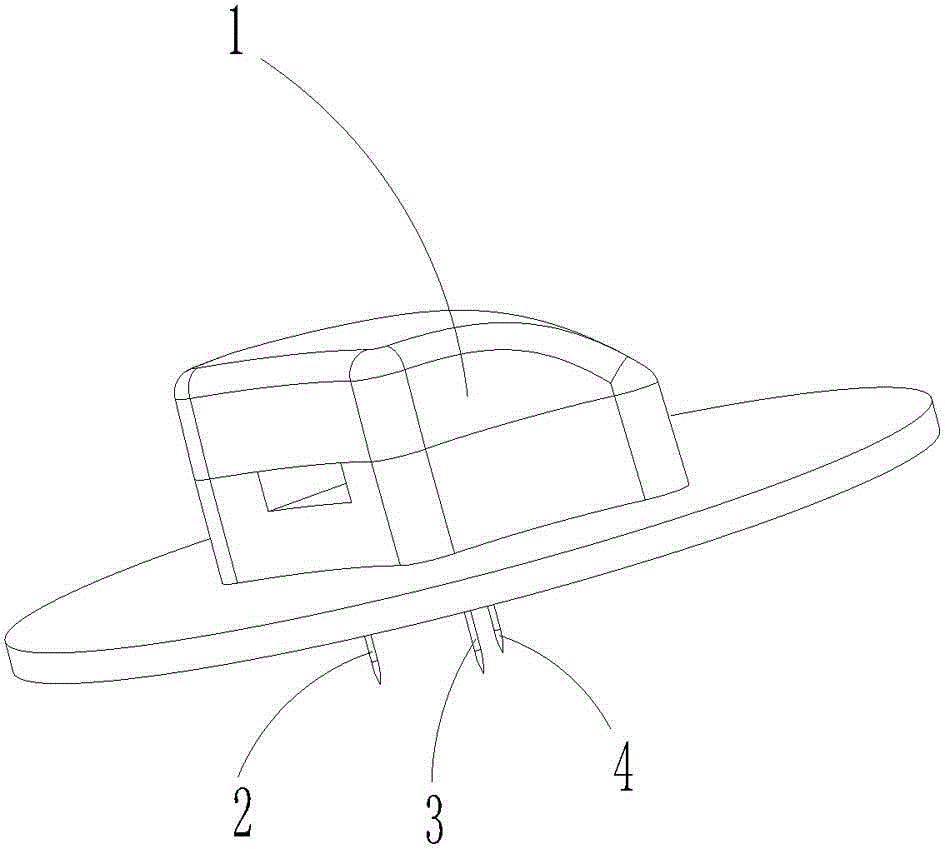Subcutaneous tissue interventional type needle glucose sensor and its preparation method
A glucose sensor and subcutaneous tissue technology, applied in the field of sensors, can solve the problems of insufficient fixed amount of glucose oxidase, poor anti-interference ability, high compactness of structure, and achieve the advantages of being beneficial to mass production, improving accuracy, improving stability and The effect of reliability
- Summary
- Abstract
- Description
- Claims
- Application Information
AI Technical Summary
Problems solved by technology
Method used
Image
Examples
Embodiment 1
[0062] Embodiment 1: as figure 1 , figure 2 , image 3 , Figure 4 , Figure 5 , Figure 6 and Figure 7 As shown, a subcutaneous tissue-intervening needle-shaped glucose sensor includes a base 1, the bottom of the base 1 is provided with a working electrode 2, a counter electrode 3 and a reference electrode 4, and the working electrode 2, counter electrode The electrode 3 and the reference electrode 4 form a split needle-shaped three-electrode system;
[0063] The working electrode 2 includes a working substrate 5, the outer surface of the working substrate 5 is covered with a working inert metal layer 6, and the outer surface of the working inert metal layer 6 is covered with a working catalytic layer 7. The outer surface of the working catalytic layer 7 is covered with a working inner modified layer 8, the outer surface of the working inner modified layer 8 is covered with an enzyme layer 9, and the outer surface of the described enzyme layer 9 is covered with a work...
Embodiment 2
[0101] Embodiment 2: The preparation method of the subcutaneous tissue-intervening needle-shaped glucose sensor is carried out according to the following steps:
[0102] (1), preparation of working electrode:
[0103] The working electrode includes a working substrate, a working inert metal layer, a working catalytic layer, a working inner modification layer, an enzyme layer, a working modification layer, a working polymer layer, a working outer modification layer, and a working hydrophilic layer;
[0104] Working electrode dimensions, diameter 0.25mm, length 6mm or less;
[0105] Its preparation method is as follows:
[0106] ①. The material of the working substrate is metal or non-metal;
[0107] ②. The working inert metal layer is prepared by electroplating and sputtering;
[0108] ③. The working catalytic layer is platinum black, which can be prepared by electroplating;
[0109] ④. The solution used for the modified layer: the solvent is ethanol or tetrahydrofuran, the...
Embodiment 3
[0135] Embodiment 3: The preparation method of subcutaneous tissue-intervening needle-shaped glucose sensor is carried out according to the following steps:
[0136] (1), preparation of working electrode:
[0137] The working electrode includes a working substrate, a working inert metal layer, a working catalytic layer, a working inner modification layer, an enzyme layer, a working modification layer, a working polymer layer, a working outer modification layer, and a working hydrophilic layer;
[0138] Working electrode dimensions, diameter 0.3mm, length 6mm or less;
[0139] Its preparation method is as follows:
[0140] ①. The material of the working substrate is metal or non-metal;
[0141] ②. The working inert metal layer is prepared by electroplating and sputtering;
[0142] ③. The working catalytic layer is platinum black, which can be prepared by electroplating;
[0143] ④. The solution used for the modified layer: the solvent is ethanol or tetrahydrofuran, the solute...
PUM
 Login to View More
Login to View More Abstract
Description
Claims
Application Information
 Login to View More
Login to View More - R&D
- Intellectual Property
- Life Sciences
- Materials
- Tech Scout
- Unparalleled Data Quality
- Higher Quality Content
- 60% Fewer Hallucinations
Browse by: Latest US Patents, China's latest patents, Technical Efficacy Thesaurus, Application Domain, Technology Topic, Popular Technical Reports.
© 2025 PatSnap. All rights reserved.Legal|Privacy policy|Modern Slavery Act Transparency Statement|Sitemap|About US| Contact US: help@patsnap.com



